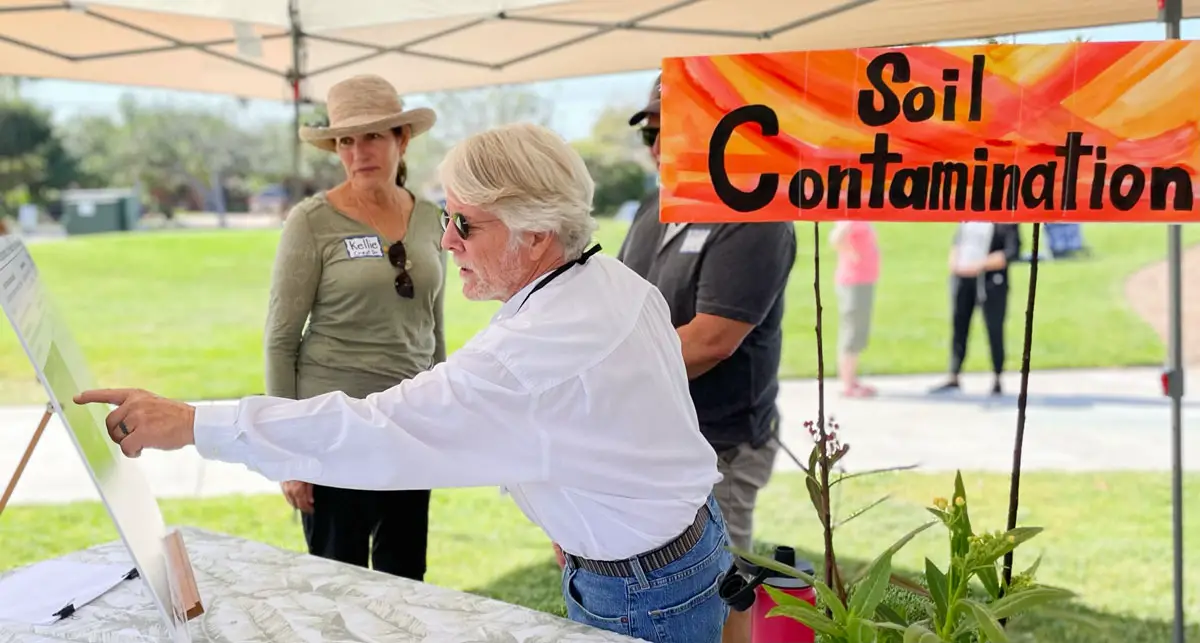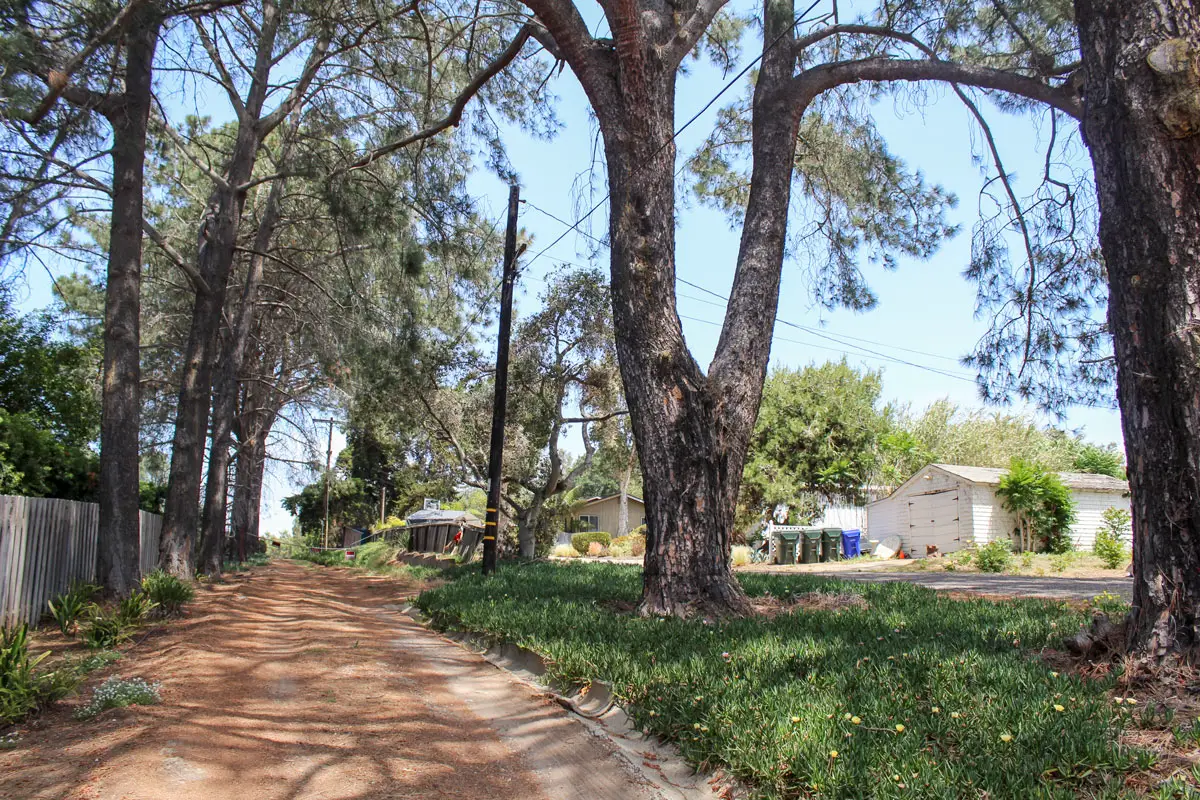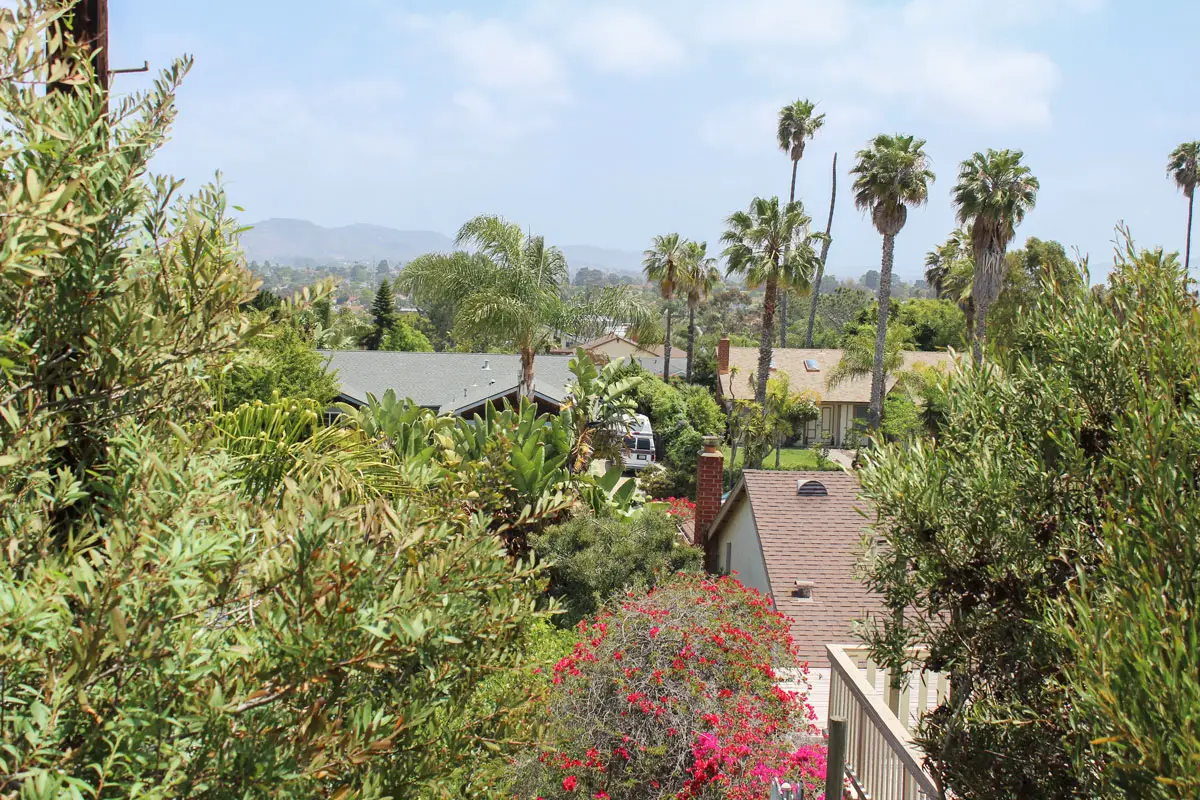ENCINITAS — A growing number of residents are expressing concerns about a proposed residential housing development project south of Cardiff that critics say lacks proper environmental safeguards, suffers from poor infrastructure design and poses potential hazards to human health.
Hundreds of concerned residents gathered at an informational meeting on April 30 at the Bethlehem Lutheran Church hosted by the community group Melba Alliance for a Safe and Healthy Environment, or MASHE.
During the event, presenters outlined various concerns with the Torrey Crest project, a proposed 30-lot development on a 7-acre parcel located between Melba Road and Oak Crest Middle School.
The project’s proposal, submitted by developer Torrey Pacific Corporation, is currently being reviewed by city officials and may come before the Encinitas City Council for approval later this year, according to Brian Staver, a manager at Torrey Pacific. The developer’s most recent pitch to the city marks the third proposal for the project since Jan. 2021.
However, to some Encinitas residents living alongside the proposed project site, including those gathered over the weekend, the proposal as it currently stands prioritizes expediency and cost-cutting measures over environmental conscientiousness and poses potential threats to both ecological systems and human habitation.
Toxic chemicals
A major concern is the planned disposal of toxic chemicals concentrated in the development grounds. According to the city’s environmental impact report conducted last year, the soil of the proposed site contains substantive concentrations of numerous toxic pesticides now banned under state and federal law, including chlordane and dieldrin.
Both of these substances are considered persistent organic pollutants and are extremely resistant to natural degradation. Additionally, both chemicals are linked to causing various harmful conditions such as cancer, diabetes, and neurological disorders.
The plan in the current proposal of the Torrey Crest project being reviewed by the city is to excavate and encapsulate 80% of the pesticide-impacted soil beneath a plastic soil cover that will be buried 7-feet below ground level. The burial location will be underneath three of the lots located just south of the Oaks Crest Middle School off Balour Drive.
Approximately 20% of the most pesticide-impacted soil at the site will be disposed of at an offsite waste disposal facility.

But for Jean-Benard Minster, a Cardiff resident and retired geologist, this isn’t enough. Minster and other residents argue that all of the impacted soil should be taken off-site for treatment as a precaution, even though doing so would be significantly more costly for the developer.
The geologist also said he’s extremely worried about the potential for toxic dust generation near the school coming from the impacted soil being dug up and handled during excavation.
“We’re concerned about these chemicals being dug up during development, now there are techniques to prevent the dust blowing into the air from going towards the school, so we want to make sure that these techniques are obeyed and instrumented with great care,” Minster said. “If they dig it up with dry dirt it could easily blow just twenty feet away into the classrooms, and then there are the Alrich Avenue homes to the east, or if a wind comes from the desert the people to the west could be at risk as well.”
Lori Forsythe, a resident who lives on Alrich Ave just across from the middle school, echoed Minster’s concerns regarding toxins in the area.
“Just the dust alone is going to be concerning, regardless of how they bury this stuff, wherever they bury it,” Forsythe said. “It’s a double-edged sword — either the school suffers or we suffer. This should all be trucked off-site and stored somewhere else. Yes, it’d be more expensive but you’re already making a lot of money from this development so, come on. This isn’t about ‘Not in My Backyard’ (NIMBY). This is a beautiful area and it should be developed. But be responsible about it and don’t bury this stuff 15 feet away from a school.”
Staver responded to the concerns about the airborne hazard posed by the pesticides by pointing out that Torrey Pacific’s proposal is in full compliance with state and municipal guidelines concerning the handling of the pesticides.
“Our approved soil remediation plan and community health and safety plan, which were completed based on comments and suggestions provided by the Department of Environmental Health (DEH), include specific provisions to ensure safety during the excavation process,” Staver said.
“For example, the plan requires perimeter, real-time airborne dust monitors which log total dust levels every 60 seconds and sound an audible alarm if dust action levels are triggered. The DEH is the lead agency for the applicable federal, state, and local regulations and has overseen the remediation of many similar pesticide cases in the City of Encinitas. We expect the excavation and burial of the impacted soil to take less than a week once the site has been prepared for that work.”
Staver also denied that Torrey Pacific was cutting any corners by not exporting all of the impacted soil off-site.
“For the 20% of our impacted soil where concentrations are highest, we are disposing of the soil off-site, as required by the DEH,” Staver said. “For the remaining 80%, where concentrations aren’t as high, we have a high degree of confidence that this can be safely buried on-site without impacting the safety of residents and neighbors. The DEH, which has dealt with many cases of soil contamination by these pesticides, has approved this plan as safe.”
Drainage and hydrology
A second major category of concern for residents is the development’s effects on drainage and hydrology. The developer’s proposal is to capture all of the runoff from the site and direct it into a bioretention basin (to help treat stormwater runoff) located in the southwestern portion of the property adjacent to Melba Road.
After flowing into a vault to mitigate the runoff rate to a more feasible level, the system is designed to where water will percolate from the vault into two dry wells that sink 70 ft. deep into the ground.
According to Minster, this method of stormwater capture has never been utilized before in residential developments in San Diego County. Given the sloped topography of the development, which sits on a hill relative to the surrounding neighborhoods, Minster expressed concerns about potential flooding coming from the site.
Minster said MASHE and community members living around Torrey Crest are worried the system may not be able to accommodate a large amount of runoff that is projected to come from the new development. Minster estimates a 334% increase in stormwater runoff once the project is completed.

“When it comes to drainage, the existing calculations made by the developer have been insufficient up to this point, it’s been entirely inadequate,” said Minster. “I do think it’s possible that this method of capture can be made to work. The first thing you need to do though is to make sure that the simulations, the calculations, are full and viable, and right now this proposal is insufficient, very superficial, and very simplified.”
Lois Carroll, a 40-year Encinitas resident who lives on Witham Road, said that she’s considering moving because she anticipates considerable damage to her property, which is located at a downhill slope from the development site, during the event of any major storm event.
“I’m extremely worried about the flooding, and my neighbors, too,” Carroll said. “We’re aggravated. I asked one of the project engineers, ‘Where else has this [bioretention] method been used in a residential area in Encinitas?’ There was no response. It’s just unprecedented.
“If there’s any flooding at all, what will happen? It’s a problem. In my [opinion], the water will not be absorbed into the ground because there’s so much concrete with the [development] and there’s not a lot of soil for it to go into, so the concrete creates runoff, water that’s going to go down the hills. Basically, the topography of the area sets it up for flooding.”
Staver said the concerns over increased runoff are based on hydrological miscalculations. The developer said the project’s bioretention system will filter stormwater so effectively that there will actually be less stormwater runoff on-site than there is currently without any development.
“Our calculations, which were made in accordance with all relevant guidelines in the city’s engineering design materials, show that, even at the level of a 100-year storm event, there would be less runoff leaving the site post-project than there would be currently,” Staver said. “We have not seen a copy of the document that supports the claim that there is a 334% increase in runoff, but we have been told this number does not take into account any mitigation measures, such as the basin and dry wells.”
A second concern regarding the project’s drainage has to do with where the runoff will go from the dry wells. Water from the development goes through the process of biofiltration in the bioretention basin, a pollution control technique that treats stormwater through natural physical, chemical, and biological processes.
According to a report conducted on the project by a private civil engineering firm, runoff from the development will be fully contained within the two dry wells in the basin in the event of any 2- or 10-year storm.
However, Minster and other MASHE members say they aren’t fully convinced by the conclusions of this report.
Suzie Sherwin, a MASHE organizer, says that she’s worried about what will happen if the stormwater from the development exceeds the runoff capacity of the dry wells, especially during a major storm event.
“It’s not clear to me where the water would go that goes into the dry wells, at what sandstone layer would it stop? Once the water hits the most impermeable layer of sandstone in the ground it will flow downhill,” Sherwin said. “It will spill down onto Melba, past churches, different schools and eventually into the Batiqutos Lagoon and protected water areas, and if the stormwater is carrying soil contaminants that’s really not a good idea.”
Minster argues that the excess water from the drywells during storms is likely to flow either north towards the Batiquitos Lagoon, or south towards Cottonwood Creek and Moonlight Beach, raising the prospect the development could add to existing pollution situations at both watersheds.
“We need to figure out where does that water go after permeating into the ground at dry wells,” Minster said. “Does it add to existing pollution situations? How clean does the water go in and how clean does it come out? If it goes in with some pollution, it’s possible that the water gets filtered by the earth adequately but they haven’t demonstrated that. I’m worried about Cottonwood Creek and Moonlight Beach, and I’m also worried about the Batiqutios Lagoon and even Encinitas Creek.”

Staver disputed the claim that dry wells haven’t been used before in Encinitas, and asserted Torrey Pacific’s moire modern techniques for stormwater management are actually becoming increasingly common. Staver also said the developer’s studies show that water in the drywells will move vertically, rather than horizontally, toward nearby watersheds.
“If water from the dry wells were to flow to Cottonwood Creek or the ocean, it would have been cleaned first by the biofiltration process,” Staver said. “However, our studies suggest that water that does go into the dry wells would continue to filter downward vertically into the permeable Torrey Sandstone formation and lower sedimentary basins, rather than moving horizontally to reach the ocean or nearby creeks and canyons. Cities and the State have strengthened requirements for stormwater treatment greatly in recent years, and our project is designed to meet all current code requirements.”
The third topic of concern discussed at Saturday’s MASHE gathering related to the planned removal of 172 trees from the 7-acre site. While Torrey Pacific has pledged to replace the removed trees on a one-to-one basis (meaning a new tree will be planted for each tree that is cut down), Cardiff locals say they’re concerned about the impacts that such extensive tree removal will have on local flora and fauna.
“I am concerned about what this will mean for the local ecology,” Minster said. “Monarch butterfly populations could be at risk among other things, we’re trying to negotiate with the developer about preserving some of these trees but what we want is to preserve the nature of this neighborhood. And that will ultimately be very difficult to do with high-density development.”
Caroll expressed skepticism about the developer’s tree replacement pledge.
“I mean, realistically are they going to replace these trees with new 50-foot trees? No, they’re going to replace them with a scrawny stick,” Carroll said. “I can’t see why the builder can’t just build with the flow of the land, why do they have to go slash and burn, cut everything down and start over again. It’s sad, it’s very very sad.”
Sherwin said that Mashe has identified a list of 55 bird species, 12 species of mammals, six reptile species, and countless insect populations, including monarch butterflies and bees, that will be impacted by the development.
“They [Pacific Corporation] have made the claim that, ‘Well, there aren’t actually any mammal populations that will be threatened by this,’ but we literally see coyotes and other animals out here all the time, so it’s just not true, this is definitely going to have an impact,” Sherwin said.
Staver said that while the removal of the trees, many of which are on the city’s invasive species list, is an unfortunate necessity, the impacts on local flora and fauna would be minimal and offset by Torrey Pacific’s tree replacement efforts.
“We know that some residents are concerned about the density of the housing on the site; for construction purposes, however, whether the project proposes 15 or 30 houses, these trees would still need to be removed,” Staver said. “While it is the case that mature trees on-site will not be replaced with similarly sized trees, this one-to-one tree replacement we are planning provides for much more extensive replacement of trees than would have been required by the city even three years ago on this exact same site.”




2 comments
I really appreciate the thoroughness with which you researched and wrote this article educating the public about the Torrey Crest development. However, there is a crucial concern not included in your article—the limited provision of affordable housing. Under the current density bonus law (AB 2345), the Torrey Crest developer is allowed to build a minimal number of “affordable” homes while building a majority of market-rate units (i.e., out of the 30 homes to be built, only 3 are designed for lower-income residents). In addition, the Torrey Crest developer intends to remove currently occupied lower-income rentals on the property without adding back those units to the total number of affordable units.
We have already seen in other parts of Encinitas how loopholes in the current housing laws have allowed developers to build a minimal number of affordable units, buy the affordable units they do build and then rent them, sometimes to people in their own families. So, exactly who stands to benefit most from the housing laws as they are currently interpreted? I think we all know the answer to that!
Those of us who support affordable housing would like to see the news media take the lead in alerting the public to what is being allowed to occur under the current housing laws. Clearly this travesty is not limited to the Torrey Crest project, but drawing public attention via this project can demonstrate the need to call out politicians in Sacramento and those who aspire to be in Sacramento to own up to their unfounded claims that our State is taking adequate and effective measures toward providing sufficient housing for lower- and middle-income people.
CJM
Thank you for your accurate and amazing coverage of this potential environmental nightmare housing project. Goodson 2.o
Comments are closed.